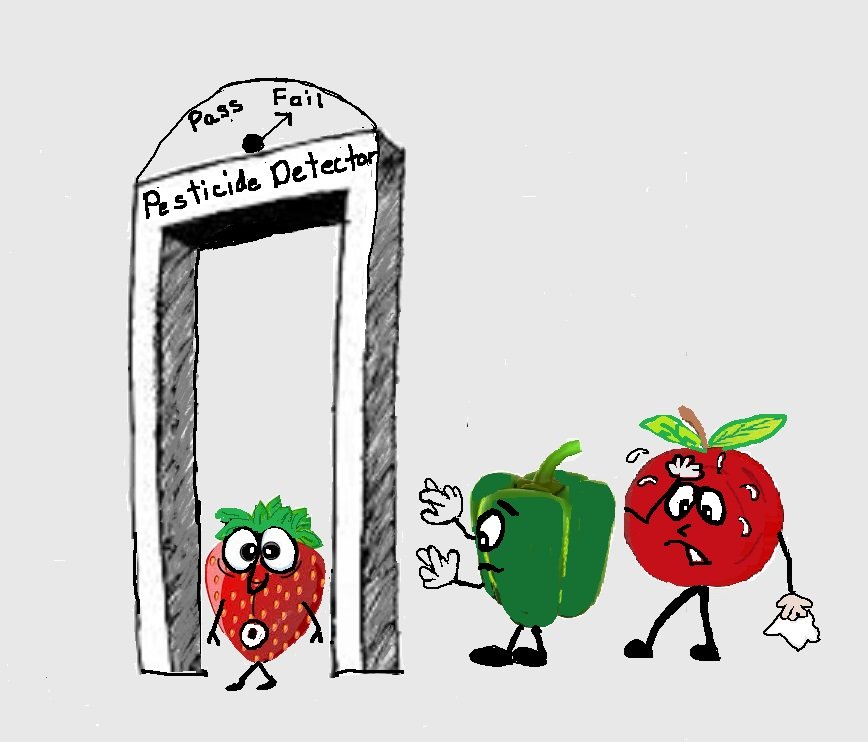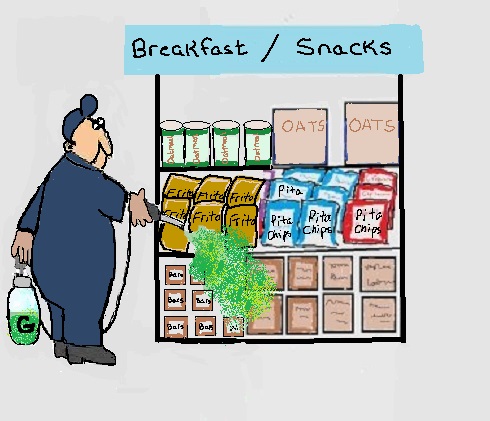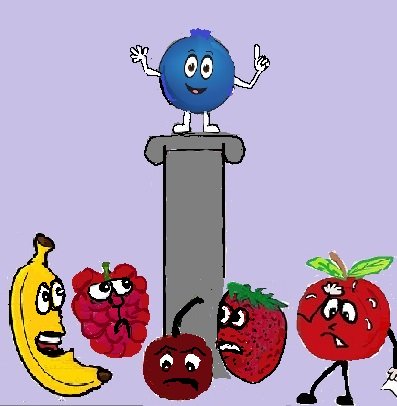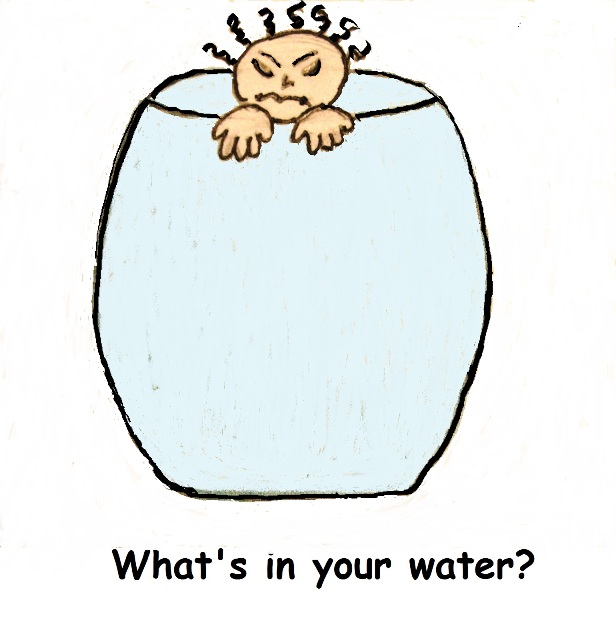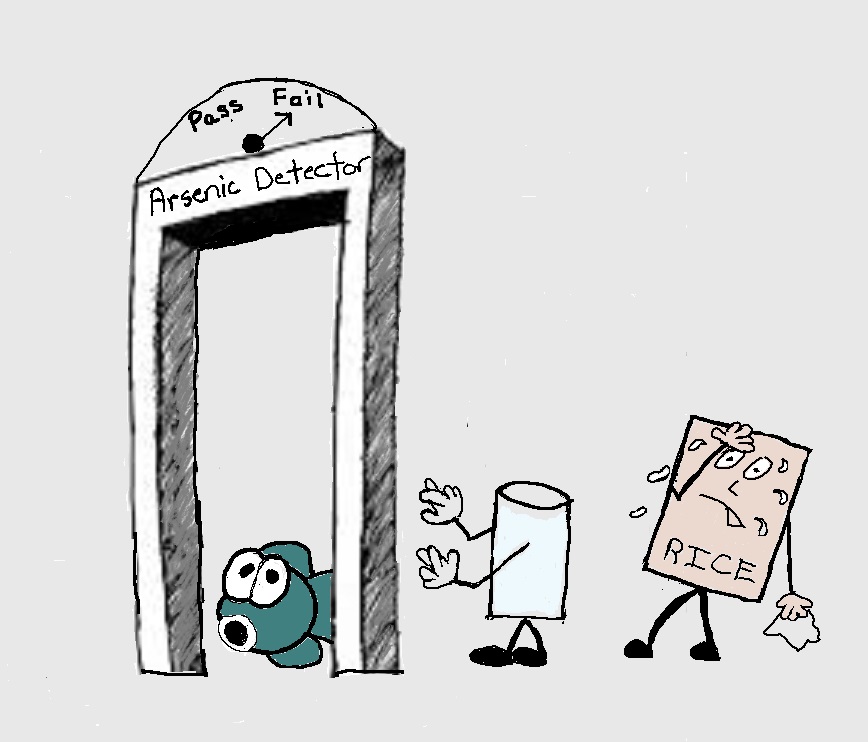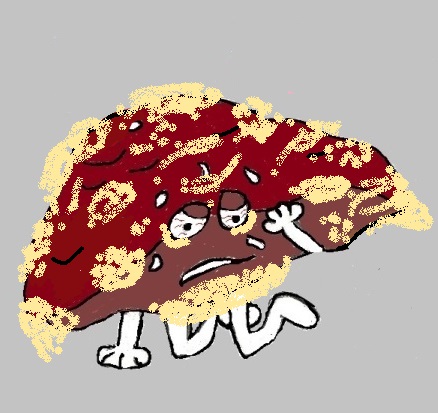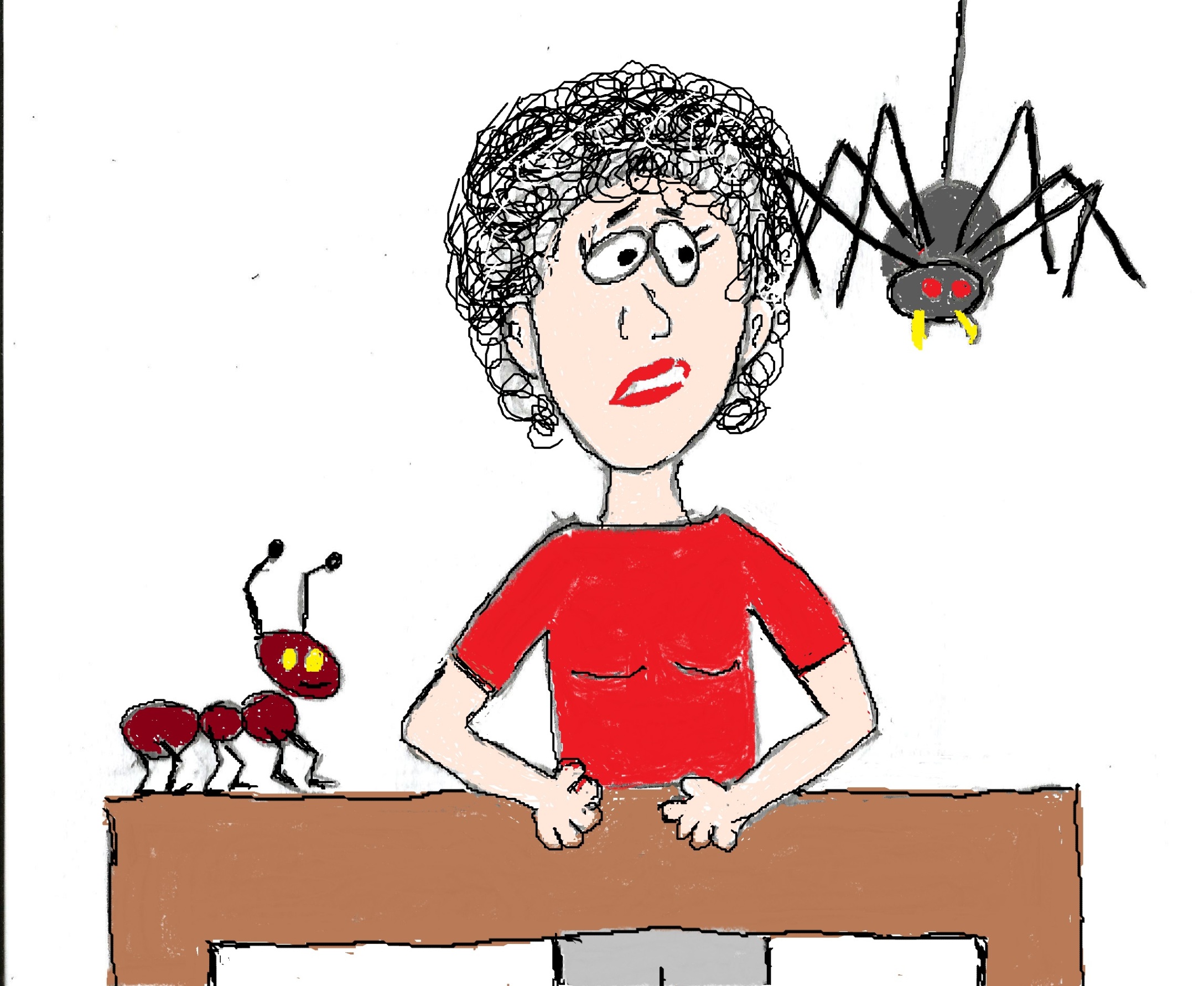- Home
- Toxic Chemicals in Food
- Pesticides in Fruits
Pesticides in Fruits and Vegetables
Eating lots of fruits and vegetables is a healthy choice. But exposure to the pesticides in fruits and veggies is the opposite of healthy.
Many pesticides are endocrine disruptors that contribute to obesity, diabetes, and other metabolic disorders. And some cause cancer and fatty liver disease.
There are 2 government agencies that test your food annually for pesticide residues, the FDA and the U.S. Department of Agriculture (USDA).
FDA sampling has been shrinking over the years, dropping about 25 percent from a decade ago from more than 7,900 samples to 5,989 samples tested in its latest report. In 2012, the USDA tested 12,546 samples per year. By 2018 that number dropped to 10,545.
But the pesticide residues on food rise and fall. Recently, the FDA pesticides on about 47.5% of domestic food and 50% of imported foods. In 2010, about 37 percent of domestic and 28 percent of imported foods were found with residues.
The chart below shows the percent of samples with pesticide residues reported by the USDA. Notice that in 2015 a whopping 85% of food tested had pesticide residues.
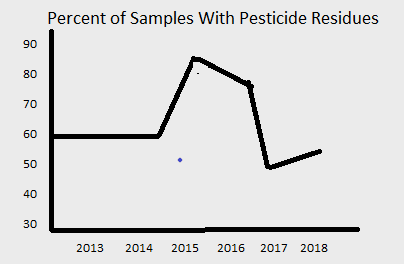
And I need to point out something. These pesticide residues are found on fruits and vegetables AFTER they’ve been washed under cold running water for approximately 15-20 seconds.
The Pesticides You're Exposed To In Produce
It’s nearly impossible to list the pesticides found in all
types of vegetables and fruits. There are over 1000 different pesticides that
are used to grow crops.
Plus there are many pesticides registered for use on the same crop. They include combinations of insecticides, fungicides and herbicides.
Also, the specific pesticides used can vary with different growing seasons, different pest problems and the region or country where the crop was grown.
Sometimes pesticides end up on crops unintentionally when it drifts from other fields. Plants can also absorb pesticides that linger in soil for years after application.
A good example of this is DDT, which was banned in the U.S in 1972. DDT takes a long time to breakdown in the soil (half-life is 50 years). Because of this it is still a common pesticide residue found on produce, even organic fruits and vegetables.
The FDA tests for 761 pesticides that may be found as residues. Residues of 221 different pesticides were actually found in the samples analyzed in its most recent report. The most frequently detected were Imidacloprid Boscalid and Azoxystrobin.
USDA Pesticide Residue Report
The most recent USDA report available (2018) found pesticide residues on 52.8% of produce tested. 99% of the residues were below the exposure limits set by the EPA.
However, keep in mind that exposure limit testing is really inadequate and often contradicted by independent scientists. Plus, safe exposure limits are unknown for many pesticides.
For example, 642 samples were found to have pesticides for which no safe level (tolerance) was established, including 444 fresh fruit and vegetable samples, 151 processed fruit/vegetable samples, 30 rice samples, and 17 wheat flour samples.
- 508 samples contained 1 pesticide for which no tolerance was established.
- 106 samples contained 2 pesticides for which no tolerance was established.
- 13 samples contained 3 pesticides for which no tolerance was established.
- 13 samples contained 4 pesticides for which no tolerance was established.
- 2 samples contained 7 pesticides for which no tolerance was established.
And the USDA doesn't test for every possible pesticide. A very notable example is glyphosate, the most widely used herbicide in the world.
You can go to http://www.whatsonmyfood.org/ to investigate the pesticides found on different fruits and vegetables by the USDA.
Harmful Effects of Pesticides in Fruits and Vegetables
There are many health issues linked to pesticide exposure. Generally, insecticides and fungicides are more toxic to humans than herbicides (2,4D and Atrazine are huge exceptions to this).
Many insecticides are neurotoxins and act on insects and humans in much the same way. Because they’re toxic to your nervous system, exposure to them is linked to Parkinson’s and Alzheimer’s.
Fungicides are often applied near harvest time to prevent mold during transport. They are classified as endocrine disruptors and carcinogens. Exposure to fungicides has also been linked to hypothyroidism and breast cancer.
Some herbicides, such as atrazine, may cause cancer, reproductive or developmental effects, and endocrine system effects.
Chlorpyrifos, used on corn, cranberries, Brussels sprouts, and broccoli, can have harmful neurodevelopmental effects on fetuses and on young children. Research also ties the chemical to attention deficit problems, tremors, and autism.
2,4-D is an endocrine disrupter that interferes with thyroid hormones. It’s also linked to risk factors for acute myocardial infarction and type-2 diabetes and poor semen quality. Cancer risks include non-Hodgkin lymphoma in people and malignant lymphoma and bladder cancer in dogs.
And here’s something to ponder - as I mentioned above, neither the FDA nor the USDA has tested food for glyphosate (the active ingredient in Roundup). Even though it’s the world's most widely used herbicide, and testing by academics, consumer groups and other countries has shown residues of this weed killer is common in food.
Glyphosate exposure can affect your health in a bunch of different ways. It is also an endocrine disruptor, it damages DNA, causes cell death and kills the beneficial bacteria in your gut.
Plus, it contributes to cancers of the liver, kidney, bladder/urinary and thyroid. If that list isn’t scary enough, glyphosate also messes with your body’s ability to breakdown the toxins you are exposed to everyday.
In 2010 the President’s Cancer Panel report Reducing Environmental Cancer Risk: What We Can Do Now had this to say “Nearly 1,400 pesticides have been registered by EPA for agricultural and non-agricultural use. Exposure to these chemicals has been linked to brain/central nervous system, breast, colon, lung, ovarian, pancreatic, kidney, testicular, and stomach cancers, as well as Hodgkin and non-Hodgkin lymphoma, multiple myeloma, and soft tissue sarcoma… Approximately 40 chemicals classified by the International Agency for Research on Cancer (IARC) as known, probable, or possible human carcinogens, are used in EPA-registered pesticides now on the market.”
Imported Versus Domestic Produce
So how do the levels of pesticides in fruits and vegetables grown domestically compare with imported produce? Is domestic produce safer than imported?
Again, not a simple answer. It depends on the country where the fruits and vegetables come from and the types of produce. Some countries have different safe exposure levels and some pesticides that were banned in the U.S. are still used in other countries.
While imported produce is supposed to meet U.S. pesticide residue guidelines, only about 1% of all imports are tested by the FDA. Kinda scary considering one half of the fruits and a quarter of the vegetables that we consume are imported.
Remember, the FDA found pesticide residues in 47.5% of the domestic and 50% of the imported food samples that were tested. The big difference between domestic and imported produce is the violation rate (meaning unsafe levels were detected).
The violation rate of import samples is 3-5 times higher than the rate for domestic samples. In its most recent report unsafe residue levels were found in 3.8% of the domestic samples and 10.4% of the import samples.
The most recent FDA pesticide monitoring results found that for domestic produce:
- 62.5% of vegetables had pesticide residues
- 9.4% of these residues were above the safe limit set for exposure
- 85.8% of fruits had pesticide residues
- 1.8% were above the safe limit set for exposure
For imported produce:
- 58% of vegetables had pesticide residues
- 12.5% of these residues were above the safe limit set for exposure
- 60% of fruits had pesticide residues
- 7.9% were above the safe limit set for exposure
*Unsafe levels of pesticides were found in 48.3% of imported cilantro, 25.8% of kale and 14.8% of leaf lettuce.
Why You Should Make The Switch
So, you might be thinking – will switching to organic produce really make a difference? Well, according to diet intervention studies conducted since 2008 it really would make a difference.
Diet intervention studies measure levels of certain pesticides in the bodies of participants eating a regular diet. The participants then switch to organic produce and after a week pesticide levels are again measured in their bodies.
A 2019 study conducted by researchers at the University of
California at Berkeley School of Public Health tracked pesticides levels in a small group of participants on a conventional diet and after
switching to an organic diet.
Before switching to an organic diet the researchers found 14 different compounds that represented up to 40 different pesticides in the families that participated. After just six days on the organic diet, overall pesticide levels dropped 60.5 percent in both the adults and children.
After eating organic food for just 6 days, there were significant decreases in 13 of the pesticides and metabolites.
Malathion, a probable human carcinogen, dropped 95 percent. The only herbicide included in the study, the endocrine disruptor 2,4-D, dropped by 37 percent
It’s not a stretch to assume that reducing the amount of pesticides in your body has health benefits. Especially for your liver, which has the difficult job of breaking down the toxic chemicals you’re exposed to.
But, we don’t just have to assume there are health benefits. Because a recent (2018) longitudinal study of nearly 70,000 adults found that eating more organic food may protect you against several types of cancer.
Other longitudinal studies found eating more organic food may reduce the occurrence of infertility, birth defects, allergies, otitis media, pre-eclampsia, metabolic syndrome, obesity and non-Hodgkin lymphoma.
There are also a few studies that found that there are higher antioxidant levels in organic food, higher levels of omega-3 fatty acids in organic dairy products and better fatty acid profiles in organic meat products.
My Approach to Organic Produce
Everything I eat is not organic. The two reasons why are availability and the fact that I like to shop at farm stands during the summer. It’s tough to find organic produce at farm stands.
You might be wondering why the higher cost of organic produce is not a factor for me. It’s certainly not because I’m rich! It's because I prioritize how I spend my money.
Although you can’t buy good health, you can buy healthy food and non toxic products to protect your health. That’s my priority.
However, there are some things that I won’t eat unless they’re organic. Apples are an example.
And not just whole apples, but any products made from apples, such as apple sauce and juice. So what do I have against non organic apples?
The Environmental Working Group publishes a list of the “Dirty Dozen” fruits and vegetables based on the number of pesticides found on them. Apples are always on the list.
Other produce that I avoid unless it’s organic include bell peppers, strawberries, raspberries, blueberries, spinach, grapes and cherry tomatoes. I also always peel anything that’s not organic.
EWG's Dirty Dozen
|
The Environmental Working Group uses the USDA and FDA pesticide residue reports to compile their list of the fruits and vegetables that have the most pesticide residues. Here’s their current list of the top 12. And, most of these fruits and vegetables make the list year after year after year. |
|
If you’re considering switching to organic foods, the dirty dozen is a great place to start. I guarantee that once you try an organic apple you’ll be hooked.
Removing Pesticide Residues From Fruits and Vegetables
Before I talk about the methods you can use to remove pesticides from fruits and vegetables I want to point something out. All the fruits and vegetables that the USDA samples for pesticide residues are washed first under running water, just like you would do at home. In other words, the residues they found were STILL on the produce AFTER washing.
Also, as part of its pesticide sampling program, the FDA conducts a Total Diet Study. For this study they wash, peel and cook about a 1,000 samples of a variety of food and then measure the pesticide residues.
In their most recent study they found six different pesticides in 10%-15% of the samples. I’ve read several studies that also show that washing and cooking will reduce but not completely remove pesticide residues.
How to Remove Pesticides From Fruits and Vegetables
You might be wondering whether it’s worth buying some type of produce wash to remove pesticide residues. Save your money (to buy more organic produce). A handful of studies have determined that washing your fruits and vegetables under running water is just as effective. Here are some steps for reducing pesticide residues from produce.
Steps
- Wash produce under running water (more effective than soaking)
- Scrub thick-skinned produce with a vegetable brush.
- Peel what you can (peaches, cucs, squash etc.)
- Dry with cloth or paper towels
- Discard outer layers of any leafy vegetable before washing.
You can also reduce surface pesticide residues with baking soda. A study published in 2017 found that soaking apples in baking soda and water and then rinsing the produce removed all surface pesticide residues.
The researchers stated that “Most pesticides are not stable at an alkaline pH, which breaks down the compounds and helps to wash them away.” That suggests that the soak probably also works for other types of produce.
BUT, the soak did not remove pesticide residues that had entered the peel, namely the fungicide thiabendazole. Fungicides are designed to enter produce to prevent spoilage. Peeling fruits and veggies are the only way to remove them. And of course organic is the best way to go!
Baking Soda Soak
- Dissolve ¼ cup of baking soda in ½ gallon of warm water. Soak produce for 15 minutes, then rinse in fresh water.
I threw a lot of information at you in this article, so let me bottom-line it. To reduce your exposure to pesticides on fruits and vegetables buy as much organic produce as is possible. Focus especially on the “Dirty Dozen”. And be diligent about washing and peeling your non organic produce.
